The whitetail deer, iconic residents of North Carolina, are a fundamental part of the state’s natural and cultural heritage. These graceful creatures, easily recognized by their distinctive white tails and majestic antlers, have successfully carved out a home in this diverse landscape, from the coastal plains to the towering Appalachian Mountains. Their impressive resilience, however, doesn’t mean they’ve been free from challenges.
In this article, we discover the largest whitetail deer ever caught in North Carolina. We explore their history, understand their habitats and behaviors, discover what they eat, and unveil their predators.

The Largest Whitetail Deer Ever Caught in North Carolina
The largest whitetail deer ever caught in North Carolina scored an astounding 228 4/8 inches and had 23 points. Don C. Rockett caught the non-typical whitetail deer in 1998. Rockett still owns the prized trophy.
When examining the Classic’s all-time list of trophy bucks, it becomes evident which counties in North Carolina have earned the reputation of being top trophy producers, albeit without scientific certainty. Rockingham County leads the pack by a significant margin with an impressive tally of seven Boone & Crockett trophies.
Following closely behind are Guilford and Stokes counties, each boasting three trophies. Additionally, several counties, namely Person, Caswell, Anson, and Moore, have contributed two record-book bucks each, further adding to the distinction of North Carolina’s trophy deer hunting regions.
The Largest Whitetail Deer Ever Caught in the World
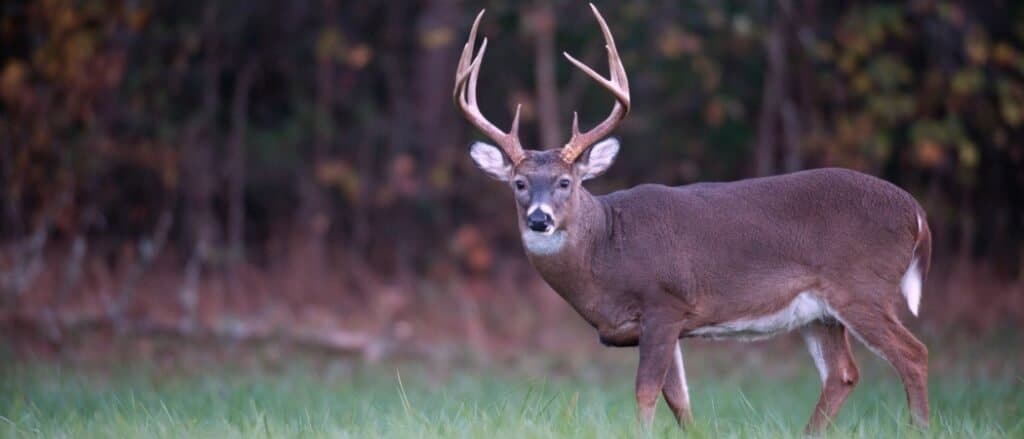
The average weight of an adult male whitetail deer is 203 pounds.
©EEI_Tony/Shutterstock.com
The record for the heaviest whitetail deer ever documented belongs to an enormous buck that tipped the scales at an estimated 540 pounds. This colossal male was hunted down by John Annett in Ontario, Canada, in 1977 and is believed to be the most massive whitetail ever witnessed.
This deer shattered the former record, which had remained unbroken for over half a century. Remarkably, this behemoth deer’s record appears to remain unchallenged, as no other whitetail has been reported to approach its impressive size in the four and a half decades that have followed.
History of Whitetail Deer in North Carolina
Now, let’s take a journey back in time. Picture North Carolina before the arrival of European settlers, a land rich with diverse flora and fauna, a landscape dominated by forests and open prairies. This was a time when the whitetail deer roamed freely in abundant numbers. They were integral to the ecosystem, influencing vegetation growth and serving as a food source for large predators.
Colonial Era: The Downfall Begins
With the arrival of the colonial settlers in the 17th century, everything started to change for our whitetail deer. These settlers relied heavily on hunting for sustenance. The deer, being a plentiful source of meat and their hides a valuable commodity for clothing and trade, faced intense hunting pressure. This overhunting, coupled with deforestation for agriculture and settlements, caused a sharp decline in the deer population. By the late 19th century, the whitetail deer, once plentiful, became a rarity in many parts of North Carolina.
20th Century Conservation Efforts: A Ray of Hope

Hunting is a common sport in North Carolina for many families.
©makalex69/Shutterstock.com
Recognizing the threat of extinction, the 20th century marked a turning point in the history of whitetail deer in North Carolina. State wildlife agencies, conservationists, and local communities rallied together. They implemented strict hunting regulations, protected and restored deer habitats, and initiated efforts to reintroduce deer in areas where they had become extinct. This period also saw the rise of wildlife management science, which further helped design effective policies to aid the recovery of the deer population.
The Present: An Encouraging Resurgence
Fast forward to today. The efforts of the past century have yielded encouraging results. The whitetail deer population has made a significant comeback in North Carolina. These resilient creatures can now be seen across the state, from the dense forests of the Appalachian Mountains to the coastal plains and even in suburban areas adjoining cities.
While the recovery is indeed a success story, it’s not without challenges. Urban expansion, climate change, and managing the balance between deer population growth and its impacts on human life and biodiversity are issues that need ongoing attention.
Habitat and Distribution
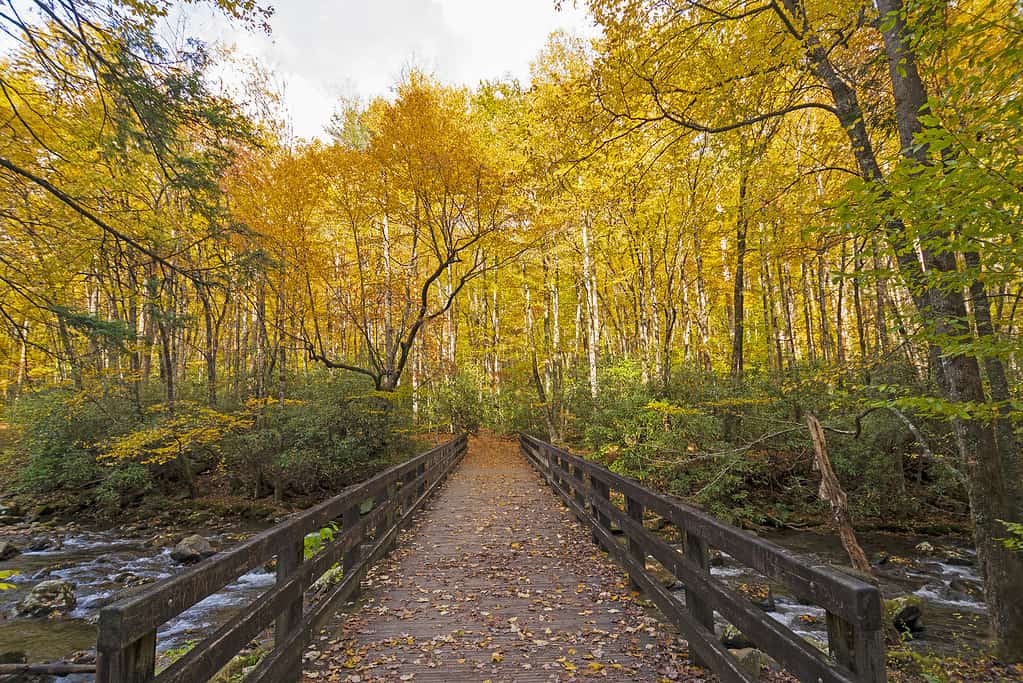
The lovely forests in North Carolina are where many whitetail deer call home.
©iStock.com/Wildnerdpix
Now, let’s take a look at where our four-legged friends like to hang out. Whitetail deer are highly adaptable creatures. They thrive in a variety of habitats across North Carolina. Ever seen a deer dart across a field into a patch of forest? That’s because they prefer areas where open lands meet dense forests, called “edge” habitats.
They’re keen on hardwood forests, pine plantations, and wetlands. But they also don’t shy away from areas close to human habitation. As a result, suburban neighborhoods with green spaces, farmlands, and even city parks can sometimes become their home.
Seasonal Nomads: Habitat Shifts with the Seasons
Did you know our deer friends are sort of nomads? They shift their habitats depending on the season. In spring and summer, they fancy areas with plenty of fresh vegetation. These places provide them with the necessary nutrients for growth and reproduction.
As fall and winter approach, they move to areas with more cover and browse—think woody plants and twigs. This cover provides protection from the cold and predators, while the browse helps them survive when other food sources are scarce.
Living Among Us: Adaptation to Human Landscapes
You might wonder, “How are there deer in my backyard?” The truth is whitetail deer have become experts at adapting to human environments. They can find food and shelter in our gardens, parks, and even alongside highways. While this close proximity can sometimes lead to conflicts—think of all those garden plants nibbled down to the stems. It’s a testament to their remarkable adaptability.
From Mountains to Coast: Distribution Across the State
Today, whitetail deer can be found throughout North Carolina. From the misty Appalachian Mountains in the west to the flat coastal plains in the east, they’ve established a presence. However, their population densities do vary, influenced by factors like the availability of food, cover, and the level of hunting pressure.
Despite facing numerous challenges over the centuries, whitetail deer in North Carolina have shown an incredible ability to adapt and survive. As a result, they continue to be an integral part of the state’s ecosystem, influencing its biodiversity and serving as a symbol of its rich natural heritage.
Behavior
Have you ever wondered what goes on in the world of whitetail deer? Well, first things first. Deer are quite the social animals. Female deer, or does, often form groups with their fawns. Meanwhile, the males, or bucks, typically hang out in bachelor groups except during the fall breeding season. But, when winter is tough, deer often band together, regardless of age or gender, for better survival.
The Mating Game: Breeding Habits

Bucks use their antlers for matches against other males to win the territory with the best does for mating.
©Sourabh Bharti/Shutterstock.com
When fall comes around, it’s all about the rut—the deer’s mating season. The bucks become more aggressive and start competing for does. They spar with each other using their antlers, all for the chance to win over the ladies. Does, on the other hand, mate with the dominant bucks, ensuring the survival of the strongest genes.
Communication: More Than Meets the Eye
Believe it or not, deer have their own ways of communicating. They use vocalizations, body language, and even scents. Ever seen a deer with its tail up? That’s a warning sign for other deer that danger is near.
The Art of Survival: Adaptation and Caution
Whitetail deer are crepuscular. Fancy word, right? It means they’re most active during dawn and dusk. It’s a clever adaptation to avoid predators who are usually out during the day or night. They are also always on high alert, ready to bound away at the slightest hint of danger. You’ve got to give it to them—their survival instincts are top-notch.
What Do Whitetail Deer Eat?
Ever wonder what our deer pals munch on? Well, let’s take a look at the menu. Whitetail deer are browsers, which means they eat a variety of vegetation. They enjoy a mix of leaves, twigs, fruits, nuts, and even some grasses. It’s kind of like they have their very own salad bar out in the wild.
Seasonal Taste Buds: Changing Preferences
Now here’s something neat. The deer’s diet isn’t always the same. It changes with the seasons. When spring rolls around, and fresh greenery starts popping up, that’s what they prefer. Then, as we move into summer, they’ll switch to munching on a mixture of leaves, herbs, and broadleaf weeds.
When fall arrives, they start to favor acorns, berries, and other available fruits. In winter, when food is scarcer, they’ll eat woody plants, barks, and twigs. It’s all about adaptability with these folks.
The Human Impact: The Deer’s New Diet
We also play a role in the whitetail deer’s diet. With more homes and developments popping up in their natural habitats, deer have started to forage in gardens, munching on vegetables, flowers, and ornamental plants. Some people even put out corn or deer feed, especially in winter. However, this isn’t always beneficial to the deer as it can create an unhealthy dependence on human-supplied food.
Predators
The whitetail deer, while being the largest native herbivore in North Carolina, doesn’t exist without threats from natural predators. Predation affects deer of all ages, but fawns are especially vulnerable due to their size and lack of strength and speed.
The Coyote: Stealthy Hunter
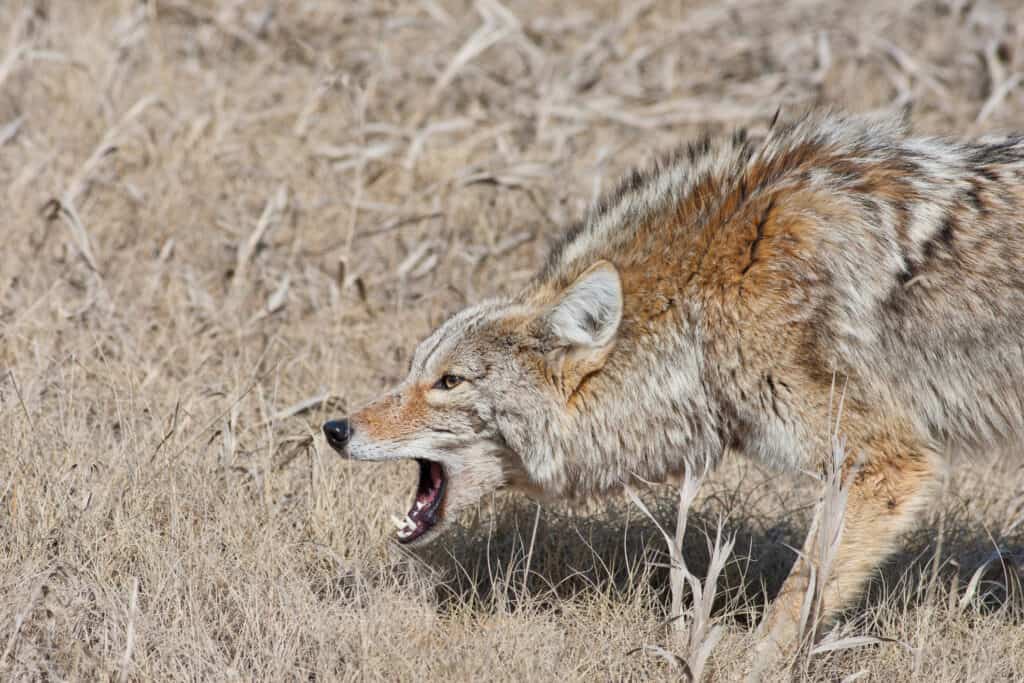
Coyotes are powerful and stealthy hunters.
©iStock.com/Songbird839
First on our list is the coyote. Coyotes pose a significant threat to whitetail deer, especially fawns, during the spring and summer months. While adult deer can often escape these cunning predators with their speed and agility, fawns are an easier target. In addition, coyotes are stealthy, versatile hunters that can adapt to various habitats and conditions, making them formidable predators.
The Bobcat: Silent Stalker
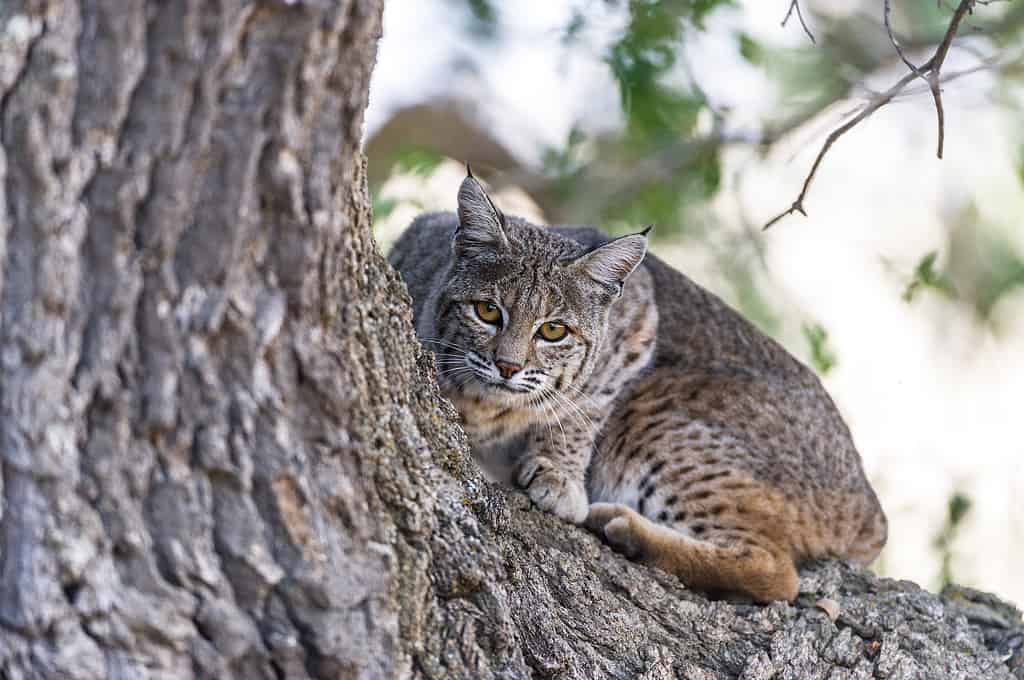
Despite their smaller size, bobcats are adept at hunting whitetail deer. These solitary hunters possess remarkable skills, relying on their stealth and ability to surprise their prey.
©iStock.com/brentawp
Bobcats, though smaller in size, also prey on whitetail deer. They are skilled, solitary hunters that rely on stealth and surprise to catch their prey. While they mostly feed on smaller mammals, they will not pass up the opportunity to take down a fawn or even an injured or weak adult deer.
Black Bears: Mighty Predators
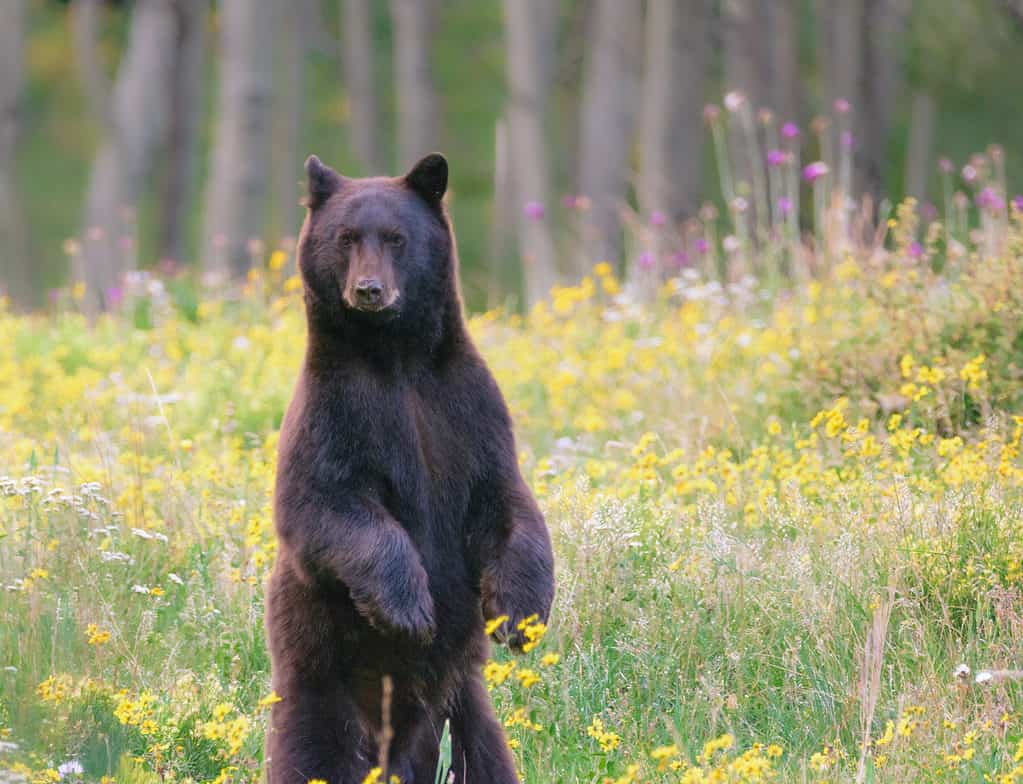
Although they don’t generally hunt for meat, they have been known to hunt deer when the opportunity arises.
©Constance Mahoney/Shutterstock.com
Black bears, another major predator of whitetail deer in North Carolina, primarily target fawns. A bear’s excellent sense of smell allows it to find and consume newborn fawns before they have a chance to escape. It’s important to note that while they can pose a threat, deer do not constitute a major part of the black bear’s diet, as they are omnivores with varied food preferences.
Birds of Prey: Aerial Hunters

Eagles can use their powerful talons to hunt small fawns.
©iStock.com/Kandfoto
Birds of prey, including eagles and large owls, can also pose a threat to whitetail fawns. These airborne hunters strike from above, often targeting young or weak animals. The power of their talons and the element of surprise make them a danger to newborn fawns.
Canine Distemper: The Disease Predator
Predation doesn’t always come in the form of a tooth and claw. Diseases like canine distemper, though not a predator in the traditional sense, can be a significant threat to deer populations. Canine distemper is a viral disease that can cause fever, respiratory distress, and neurological problems in whitetail deer, often leading to death.
Key Takeaways
We’ve journeyed through the life and times of North Carolina’s whitetail deer. These graceful creatures represent more than just wildlife; they symbolize our rich natural heritage, playing an essential role in our ecosystem and bringing joy to those who are fortunate enough to observe them. Moreover, their presence serves as a potent reminder of our shared responsibility to protect and preserve our environment.
Indeed, these deer confront many challenges, including habitat loss, diseases, and vehicle collisions. However, as we’ve discovered, numerous proactive efforts are in place to address these issues. Each one of us can contribute, whether it’s by supporting conservation initiatives, reducing our impact on their habitats, or simply learning and sharing information about these remarkable animals.
In essence, the story of the whitetail deer in North Carolina extends beyond the deer themselves. It’s a testament to the intricate relationship between humans and nature. It reflects our shared spaces, mutual challenges, and collective effort toward a future where all life thrives.
The photo featured at the top of this post is © iStock.com/twildlife
Thank you for reading! Have some feedback for us? Contact the AZ Animals editorial team.







